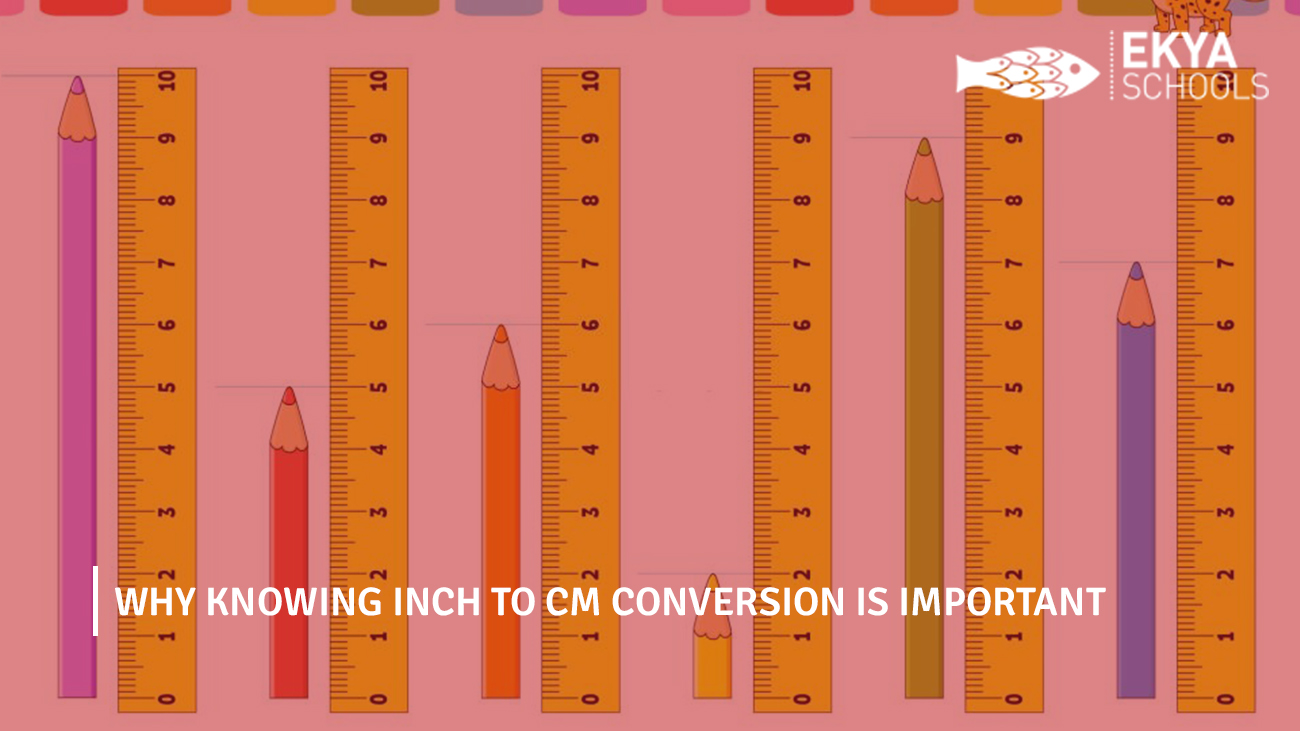Our Schools
Table of Contents
In today’s globalized world, it is important for children to be aware of different measurement systems used around the world. One of the most common measurement systems used is the metric system, which includes units such as centimeters and meters. On the other hand, the Imperial system, which includes units such as inches and feet, is still used in some countries. It is therefore important for kids to know the conversion between inches and centimeters. This blog will discuss why knowing inch-to-cm conversion is important for kids.
Understanding the Basics of Inch-to-CM Conversion
Before we dive into the importance of inch-to-cm conversion, let’s first understand the basics of this conversion.
How many centimeters are equivalent to one inch?
The measurement of one inch is equivalent to 2.54 centimeters.
Calculator for Converting Inches to Centimetres:
Utilize the inch-to-centimeter converter provided below to quickly convert inches to centimeters. Input the inch value in the designated field and receive the converted measurement in centimeters instantly.
Convert Inches to Centimeters:
cm:
Convert Centimeters to Inches:
Inches:
Definition of centimeter:
A centimeter is a unit of length in the metric system, equal to one-hundredth of a meter. It is commonly used to measure small distances, such as the length or width of an object, and is abbreviated as “cm”.
Here are the conversions of centimeters to other units of length:
1 centimeter = 0.393701 inches
1 centimeter = 0.01 meters
1 centimeter = 10 millimeters
1 centimeter = 0.010936 yards
1 centimeter = 0.032808 feet.
To measure centimeters, a measuring tape or ruler is utilized, and the units of measurement are specified. Centimeters are predominantly employed to measure small objects such as bottles, notebooks, pencils, and other diminutive items.
What is an Inch?
An inch is a unit of measurement commonly used to express length or distance. It is primarily used in the United States, the United Kingdom, and other countries that use the Imperial system of measurement. One inch is equal to 1/12th of a foot or 2.54 centimeters in the metric system. The symbol for inch is “in” or double quotes (” “).
In general, the inch is used to measure small distances, such as the length of a nail or the width of a finger, while longer distances are usually measured in feet, yards, or miles.
Here are some common conversions of inches to other units of length:
1 inch = 2.54 centimeters
1 inch = 0.0254 meters
1 inch = 25.4 millimeters
1 inch = 0.0277778 yards
1 inch = 0.0833333 feet
These conversion factors can be used to convert a length measurement in inches to the corresponding measurement in centimeters, meters, millimeters, yards, or feet.
Inches to Centimetre Conversion Chart:
| 1 inch = 2.54 cm | 11 inch = 27.94 cm |
| 2 inch = 5.08 cm | 12 inch = 30.48 cm |
| 3 inch = 7.62 cm | 13 inch = 33.02 cm |
| 4 inch = 10.16 cm | 14 inch = 35.56 cm |
| 5 inch =12.70 cm | 15 inch= 38.1 cm |
| 6 inch = 15.24 cm | 16 inch= 40.64 cm |
| 7 inch = 17.78 cm | 17 inch = 43.18 cm |
| 8 inch = 20.32 cm | 18 inch = 45.72 cm |
| 9 inch = 22.86 cm | 19 inch = 48.26 cm |
| 10 inch = 25.40 cm | 20 inch = 50.8 cm |
Difference between Inches and Centimetre:
| Inch | Centimetre |
| Abbreviated as “in” | Abbreviated as “cm” |
| 1 inch is equal to 2.54 cm | 1 cm is equal to 0.393701 inch |
| Imperial system | Metric system |
| Commonly used in US, UK, and other Countries | Widely used around the world |
| 1 inch = 2.54 centimeters | 1 centimeter = 0.3937 inches |
| Typically used to measure larger objects and distances | Typically used to measure smaller objects and distances |
Importance of Knowing Inch to CM Conversion:
Traveling Abroad: If you plan to travel abroad, it is important to be familiar with the metric system, especially if you are traveling to a country that uses it. This is because most measurements in these countries are in metric units, such as centimeters and meters. Knowing how to convert inches to centimeters will allow you to understand the measurements used in these countries and help you in your day-to-day activities.
Educational Purposes: Knowing how to convert inches to centimeters is also important for educational purposes. Children are often taught measurements in both the Imperial and metric systems in school. Converting between the two systems will help children better understand the concept of measurements and enable them to solve math problems more easily.
Scientific Applications: Science is a field that heavily relies on measurements, and knowing how to convert between inches and centimeters is crucial in many scientific applications. From measuring the length of objects to calculating the volume of liquids, a good understanding of measurement conversions is essential in science.
DIY Projects: DIY (Do-It-Yourself) projects are becoming increasingly popular among kids and adults alike. Whether it’s building a treehouse or creating a craft project, knowing how to convert between inches and centimeters will help ensure the project’s success. Accurate measurements are important in DIY projects, and knowing how to convert between the two systems will help you achieve the desired outcome.
Ekya Schools – A Leader in Pre-Primary and Kindergarten Education in Bangalore
Ekya Schools is a chain of schools in Bangalore that provides high-quality education to pre-primary and kindergarten students. The curriculum at Ekya Schools is designed to help children develop critical thinking and problem-solving skills while nurturing their creativity and imagination. The school emphasizes the importance of hands-on learning and encourages children to explore and learn at their own pace.
Conclusion
Inch-to-cm conversion is an important skill that has various benefits. It is essential for international standards, better accuracy, education, and DIY projects. Knowing how to convert inches to centimeters or vice versa will be helpful in everyday life. Ekya Schools, one of Bangalore’s leading kindergarten and primary schools, believes in making education fun and interactive. Knowing inch-to-cm conversion is a necessary life skill, and students can learn this in a fun and engaging way at Ekya Schools.
Challenges And Opportunities In India’s Education System
The Current State of Education in India:
India has made significant progress in improving the literacy rate and increasing access to education. However, there are still disparities in the quality of teaching and access to education between urban and rural areas. According to UNESCO, the literacy rate in India was 77.7% in 2019. Although there has been progress compared to previous years, there is still much room for improvement. Moreover, the quality of education in India is a significant concern. The emphasis on rote learning, lack of critical thinking, and outdated teaching methods are hindering the development of the students.Challenges in India's Education System:
Access to Education: One of the biggest challenges in India's education system is providing access to education to all students, especially in rural areas. According to a report by the Ministry of Human Resource Development, around 35% of the schools in India have only one teacher. Moreover, there is a significant dropout rate among girls due to various social and economic factors. Quality of Education: The quality of education is another major challenge in India. The emphasis on rote learning, lack of critical thinking, and outdated teaching methods are hindering the development of the students. This is further aggravated by a lack of training and professional development opportunities for teachers. Infrastructure and Resources: Many schools in India lack basic infrastructure and resources such as classrooms, libraries, and playgrounds. This affects the overall learning experience of the students and makes it difficult for them to learn in a conducive environment. Education Policy: The education policy in India needs to be revamped to meet the current needs of the students. The policy needs to focus on providing quality education, promoting creativity and critical thinking, and ensuring equal access to education for all students.Opportunities in India's Education System:
Technological Advancements: With the advancement of technology, there are several opportunities to improve the quality of education in India. The use of technology in education can help in making learning more interactive and engaging for students. Moreover, it can also help in providing access to education in remote areas. Public-Private Partnerships: The government can partner with private organizations to improve the quality of education in India. Private organizations can provide funding and expertise to improve infrastructure, teacher training, and curriculum development. Skill-Based Education: The education system in India can focus on providing skill-based education to students. This can help in preparing students for the job market and reducing the skill gap in the country.Conclusion:
Ekya, as part of the CMR Group of Institutions, has brought about significant changes in education through its focus on experiential learning, design thinking, and in-house curriculum development. These initiatives have been implemented to enhance the learning experience and ensure that students are equipped with the skills and knowledge required to succeed in the 21st century. Experiential learning is a hands-on approach to education that encourages students to learn through doing. Ekya has incorporated this approach into its curriculum by providing students with opportunities to participate in real-world projects and activities that are relevant to their lives. This not only helps students to develop a deeper understanding of the subject matter but also enhances their critical thinking, problem-solving, and collaboration skills. Design thinking is another area where Ekya has made significant strides. This approach emphasizes the importance of empathy, creativity, and experimentation in problem-solving. Ekya has incorporated design thinking into its curriculum by encouraging students to work on projects that require them to identify problems, brainstorm solutions, and develop prototypes. This helps to foster innovation and creativity in students while also developing their problem-solving skills. The in-house curriculum curated by teachers who are regularly trained on advancements in education is yet another area where Ekya has brought about significant changes. The curriculum is designed to be student-centered and focuses on the development of critical thinking, creativity, and collaboration skills. The teachers at Ekya are trained to ensure that the curriculum is relevant and up-to-date, and they use a variety of teaching strategies to cater to different learning styles and needs. Overall, these initiatives have helped Ekya to provide a well-rounded education to its students that focuses on the development of 21st-century skills. By incorporating experiential learning, design thinking, and a student-centered curriculum, Ekya has created a learning environment that is engaging, and relevant, and prepares students for success in the future.7 Tips for Balancing Technology and Screen Time
1. Setting some ground rules:
 We all lose track of time when scrolling through Instagram or watching our favourite shows. So, setting up rules about when and how long we can use our devices can help reduce screen time. This way, we'll also have more time for family bonding or physical activities. For example, how about we all agree not to use our devices during dinner? Or dedicate an entire day to digital detox by indulging in non-digitalafter-school activities.
We all lose track of time when scrolling through Instagram or watching our favourite shows. So, setting up rules about when and how long we can use our devices can help reduce screen time. This way, we'll also have more time for family bonding or physical activities. For example, how about we all agree not to use our devices during dinner? Or dedicate an entire day to digital detox by indulging in non-digitalafter-school activities.
2. Being mindful of how and when screens are used:
 It's crucial for parents to teach their kids to self-regulate their screen usage. By setting clear rules and using parental control tools, they can ensure that their children are using their devices responsibly. It's also a good idea to have separate devices for schoolwork and personal use. Some of the best schools in Bangalore teach children at an early age about the advantages of regulated screen time to maintain a tech-life balance.
It's crucial for parents to teach their kids to self-regulate their screen usage. By setting clear rules and using parental control tools, they can ensure that their children are using their devices responsibly. It's also a good idea to have separate devices for schoolwork and personal use. Some of the best schools in Bangalore teach children at an early age about the advantages of regulated screen time to maintain a tech-life balance.
3. Having some screen-free time:
 Encourage your children to set aside time for screen-free activities such as diving into a good book, taking a refreshing walk, or playing an instrument. These breaks not only cut down on screen time or help reduce technology's impact on students, but they also give everyone a chance to connect with each other.
Encourage your children to set aside time for screen-free activities such as diving into a good book, taking a refreshing walk, or playing an instrument. These breaks not only cut down on screen time or help reduce technology's impact on students, but they also give everyone a chance to connect with each other.
4. Adjusting tech expectations:
 It's not feasible to expect kids to cut out tech completely. So, the goal should be to help them moderate their tech usage, like encouraging them only to use tech for schoolwork during study hours. There are several schools in ITPL that offer alternatives to screen-based activities, showing students the importance of a balanced lifestyle.
It's not feasible to expect kids to cut out tech completely. So, the goal should be to help them moderate their tech usage, like encouraging them only to use tech for schoolwork during study hours. There are several schools in ITPL that offer alternatives to screen-based activities, showing students the importance of a balanced lifestyle.
5. Limiting app notifications:
 Do you ever find yourself distracted by a notification that says 50% off at your favourite online store? Yes? Well, kids experience the same with their apps. By helping them to limit these notifications, they can focus better on their online classes and other activities. Which, in turn, will help them reduce their screen time.
Do you ever find yourself distracted by a notification that says 50% off at your favourite online store? Yes? Well, kids experience the same with their apps. By helping them to limit these notifications, they can focus better on their online classes and other activities. Which, in turn, will help them reduce their screen time.
6. Not looking everything up immediately:
 It's important to show your kids that they don't need to run to Google every time they have a question or problem. Sure, it's easier, but it also makes them overly dependent on technology. Let's lead by example and show them that it's okay not to have instant answers. This approach can also reduce screen time plus improve their critical thinking and problem-solving skills. Schools in Byrathi are even training students to excel with limited internet access to ensure they build strong skills for a successful future.
It's important to show your kids that they don't need to run to Google every time they have a question or problem. Sure, it's easier, but it also makes them overly dependent on technology. Let's lead by example and show them that it's okay not to have instant answers. This approach can also reduce screen time plus improve their critical thinking and problem-solving skills. Schools in Byrathi are even training students to excel with limited internet access to ensure they build strong skills for a successful future.
7. Unplugging before bedtime:
 Our last tip, but certainly not least, is to support your kids to shut down their devices about 30–40 minutes before bedtime. It might seem tough, but trust us, this small change can make a big difference to sleep quality. Plus, it is also a great opportunity for them to replace screen time with calming activities like reading or meditation.
In a nutshell, technology is here to stay, and it's a big part of our lives, especially for our kids. But we have to ensure that it is enhancing their lives, not causing problems. And to do just that, finding the right balance is a must.
At Ekya Schools, we've adopted an educational approach that stresses the importance of this balance. We monitor internet usage, establish tech rules, and regulate digital activity. As one of the renowned CBSE schools in Bangalore, we're committed to helping each student achieve their personal and academic goals. If you want a quality education that's about more than just academics, enrol today!
Our last tip, but certainly not least, is to support your kids to shut down their devices about 30–40 minutes before bedtime. It might seem tough, but trust us, this small change can make a big difference to sleep quality. Plus, it is also a great opportunity for them to replace screen time with calming activities like reading or meditation.
In a nutshell, technology is here to stay, and it's a big part of our lives, especially for our kids. But we have to ensure that it is enhancing their lives, not causing problems. And to do just that, finding the right balance is a must.
At Ekya Schools, we've adopted an educational approach that stresses the importance of this balance. We monitor internet usage, establish tech rules, and regulate digital activity. As one of the renowned CBSE schools in Bangalore, we're committed to helping each student achieve their personal and academic goals. If you want a quality education that's about more than just academics, enrol today!









Leave a reply